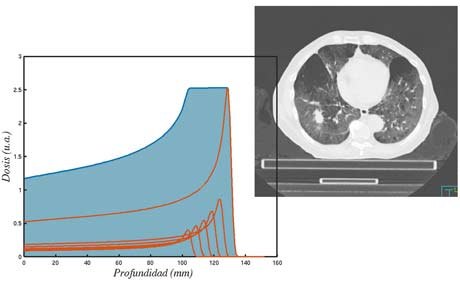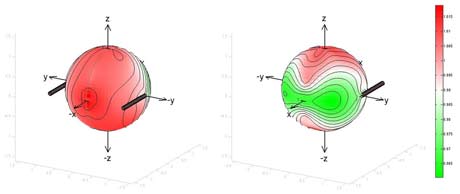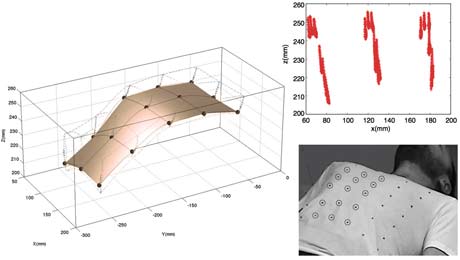The group of Medical Physics and Biophysics is integrated by researchers of the University of Navarra from the department of Physics and Applied Mathematics of the School of Sciences and from the Service of Radiation Physics and Radiation Protection of the Clínica Universidad de Navarra (CUN).
The research we carry out includes fundamental and applied research in the development of treatment and diagnostic tools, mainly those involved in the treatment of cancer using ionizing radiation, and in the physics involved in biological processes.
We have regular collaborations at national level with CIEMAT, UNED, UPC and at international level with Mayo Clinic Rochester (MCR),The Netherlands Cancer Institute (NKI), Hokkaido University, ENS-Lyon., Massachussets General Hospital at Harvard University (MGH)

Dose calculation in external beam therapy treatments is a challenge because of the high conformality of the radiation beams in current technology(IMRT and VMAT). These techniques adapt the beams to the shape of the tumour, so that the dose received by healthy tissues is small, but the associated cost is that any positioning error or movement of the tumour itself (e.g. by breathing) can affect the deposited dose.
This line aim is to combine medical imaging acquired through Cone Beam CT with image processing using deformable image registration to determine accurately the actual dose received by a patient in each treatment session. This process enables the dosimetric adaptation of the remaining sessions to achieve the prescribed dose with improved accuracy and quality.

The dose received by healthy tissues is of particular importance for pediatric patients or when a patient has to be reirradiated, in the context of long survival with recurrent disease. Proton therapy is particularly indicated for this type of treatments. This treatment modality that is available at the Clínica Universidad de Navarra in Madrid. In this research line we seek to better understand the uncertainties in the dose deposition associated with a dynamic delivery such as that of Pencil-Beam Scanning when irradiating moving tumors (lung, liver, eye).
The goal is to improve the accuracy in the dose delivery and, as a consequence, the quality of the treatment to achieve tumor control with radiotherapy. We are working on an optimized procedure and workflow to deliver the prescribed dose in lung, liver and eye tumors using our own developments in both equipment and computational tools.

Members of our group have successfully characterised small area fields and developed the use of spherical diodes as radiotherapy detectors.

Based on a technology similar to hawk-eye or CGI motion scanning, we have developed a simple, non-invasive technique that allows the tracking and monitoring of patients. It has been successfully applied in :
- Monitoring of external movement of patients in radiotherapy
- Non-invasive techniques for respiratory monitoring Issue (OTL)
- Neurology (Parkinson's patients)

Since 2006, members of group have been studying the electrical and mechanical activity of the heart through computational modelling. Moreover, we also analyse biomedical data (heart, eyes) provided by biologists and physicians. We seek to improve diagnostics and adapt the treatments that can be offered to patients. These research fields mix numerical and computational disciplines with biophysical and biomedical process modelling, as well as advanced statistical methods.

Finally, we are working on a line on Fluid Mechanics. Here we have worked on problems with applications in medicine, such as the effect of intense magnetic fields on conductive fluids (applied to the effect of magnetic resonance on the inner ear) or problems of haemodynamics. We have also studied fundamental problems unrelated to the human body, ranging from the condensation of ice crystals to the dynamo effect in the Earth's core.
Title of the project: Instabilities in out-of-equilibrium fluids (FIS2017-83401-P)
Funding Entity: Ministry of Economy, Industry and Competitiveness.
Duration: 01-01-2018 / 31-12-2021
Title of the project: development technological and clinical validation of an adaptive radiotherapy strategy in lung cancer (PI 16/00899)
Funding Entity: Fondo Investigación en Salud, Instituto Carlos III
Duration: 01-01-2017 / 31-12-2020
Members of our team have supervised physicists, engineers and physicians as PhDs on different research areas since 2004. We are convinced that the training of new generations of PhDs is crucial to maintain and increase the quality of the research at both fundamental and applied levels in any research center, being innovation a central point.
Our group welcomes graduates in Physics, Mathematics or Engineering who wish to participate in some of our projects. If you are interested in pursuing a PhD in the fields of medical physics and biophysics, please contact us.
Usually, the graduate students of our group are enrolled in the PhD program in Natural and Applied Sciences of the School of Sciences at the University of Navarra.
In addition to doctorate scholarships from public calls, the Asociación de Amigos of the University of Navarra opens each year a specific call for PhD students where new candidates can apply.

